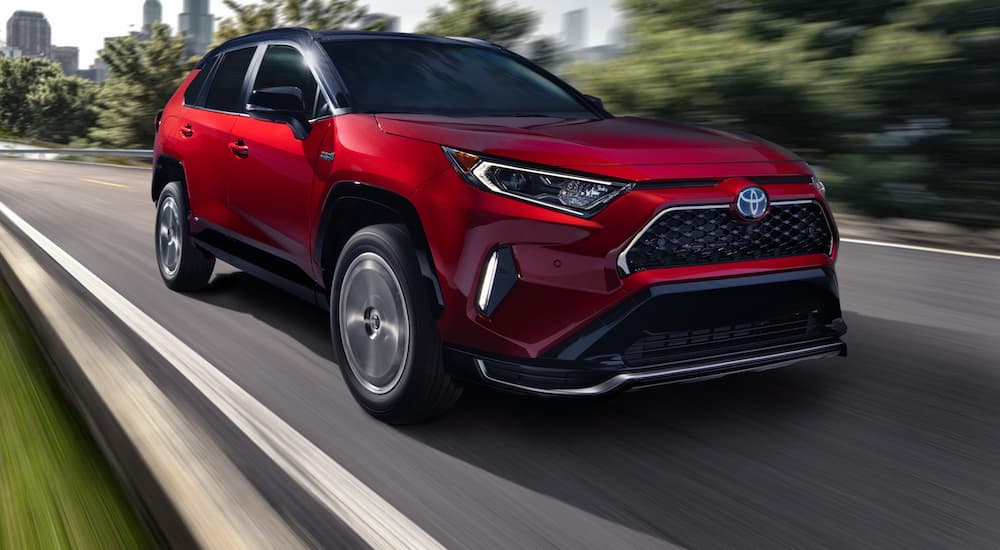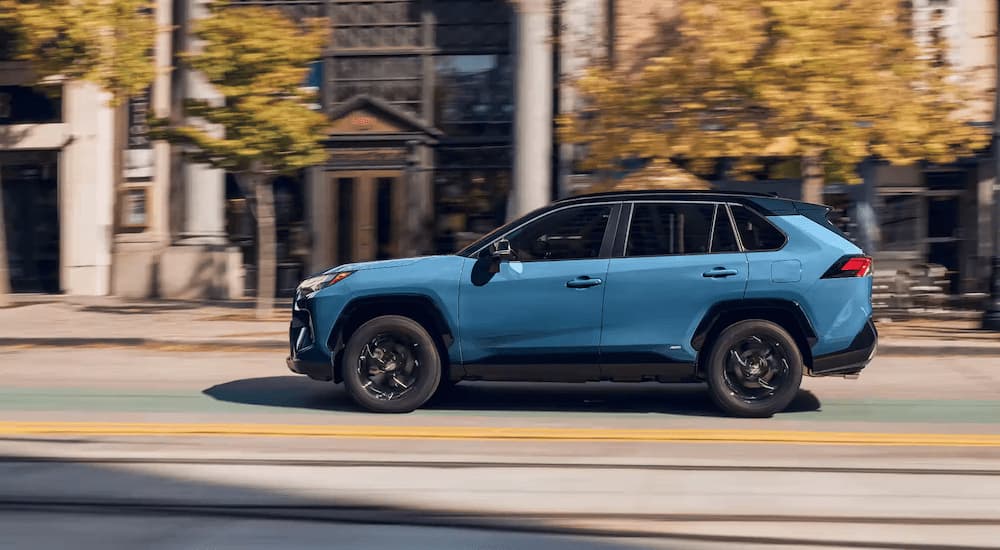Sometimes, an automaker designs a car that proves to be popular for a few years, sells well on the market, and becomes profitable for the manufacturer. Rarely does a model become an icon, continually standing out among its competitors, year after year. These are the ones folks look back at wistfully while collectors bid up the few remaining vintage models left at auctions like Barrett-Jackson. Even rarer still is a model that creates its own category. The 2023 Toyota RAV4 is the latest model in a vehicle that created the compact crossover category, dominating it since its introduction in 1996.
What was it about the RAV4? Was it the rugged styling, with the iconic full-size spare on the rear tailgate? Maybe it had to do with the fact that it had the solid ground clearance of an SUV but handled more like a car since it was based on a sedan platform and not that of a truck. For whatever reason, the Toyota RAV4 staked out a place as a pioneer, introducing so many drivers to the joys of an SUV in a smaller model. It is not an exaggeration to say that the Toyota RAV4 was one of the models that helped change popular tastes, pushing SUVs ahead of sedans and coupes.
The First Generation: The Spark of a Revolution
The RAV4 wasn’t the first compact SUV. Other automakers had put out smaller versions of their more popular full and midsize SUVs. However, these were all body-on-frame designs utilizing a truck platform. The result was small SUVs that handled poorly and provided less than optimal fuel economy. The Toyota RAV4 changed all of that. As Amy Chao, Toyota Motor North America’s senior marketing planner, points out, “a unibody SUV like the RAV4 was a crazy idea at the time. The idea of a vehicle that combined the refined driving characteristics of a car, the cargo capacity of a wagon, and the high seating position and ground clearance of an SUV was certainly revolutionary.” Today, we take these characteristics in a compact crossover SUV for granted, but they were radical when Toyota introduced the RAV4 in time for the 1996 model year.
Toyota equipped those first-generation RAV4s with a 2.0-liter I-4 gas engine. Drivers had a choice of either a 4-speed automatic or 5-speed manual transmission and provided a fuel economy of up to 23 MPG combined. The performance was solid, too, with 120 hp and 125 lb-ft of torque. Toyota offered the RAV4 with a choice of front-wheel drive for better fuel economy and four-wheel drive for better traction.
Drivers also got another interesting choice with the first-generation RAV4; in addition to the familiar 4-door model, Toyota offered the RAV4 with a more compact 2-door model, also available as a convertible. This allowed RAV4 drivers the option of letting the outdoors in on warm summer days. The first generation also started a design trend for the model, with a full-size spare attached to the rear tailgate.
The Second-Generation: An Exceptional Encore
How do you follow up on an enormous success? That is always a question that confronts automakers when they have to come up with the second generation of a wildly successful model. Fortunately, the folks at Toyota knew exactly what they were doing when they introduced the second-generation RAV4 in 2001.
The styling was changed slightly for a more refined look than the prior model. For one thing, the side panels had been changed from a two-part design with two-tone coloration to a unified side panel design. In addition, the two-door convertible had been discontinued, with just a four-door model available for sale in America. Toyota eventually phased out the 2.0-liter I-4 gas engine, replacing it with the choice of a more powerful 2.4-liter I-4 gas engine or a 2.0-liter I-4 diesel. Toyota also began to add more technological advances to the second-generation RAV4. For example, anti-lock brakes became standard, while the top trims began to offer features like an MP3 player and a navigation system.
The Third Generation: Third Times a Charm
The third generation of the RAV4 debuted in 2006, and it would be the last to feature a full-size spare on the tailgate; a shame since this feature was popular with many fans of the RAV4. Still, Toyota took steps to continue refining the looks of the RAV4. The third-generation model was given a more sloping front end with more of a slant to the front windshield. This made the third generation more aerodynamic than the prior two models. Toyota discontinued the diesel engine option; instead, it carried over the 2.4-liter I-4 gas engine from the second generation while adding a more powerful 3.5-liter V6 as an engine option, delivering an impressive 270 hp, and comes paired with a 5-speed automatic transmission.
Drivers also had an extra option with the third-generation RAV4: a third row of seats. This option gave drivers the ability to carry up to seven passengers in their RAV4. An array of safety features became standard on the third-generation RAV4. Each model featured Toyota’s Star Safety System, including features like vehicle stability control, anti-lock brakes, and multiple airbags to improve passenger safety. As you can see, each generation gave Toyota the opportunity to refine the RAV4, gradually providing new features and innovations with each model year.
The Fourth Generation: Continually Moving Forward
Toyota continued to increase the slope and aerodynamic profile of the RAV4 with the fourth-generation model. This version was introduced in 2013 and saw a number of major changes. Gone were the V6 engine option, the available third-row seat, and the beloved rear spare tire. These were replaced by a RAV4 that was more tech-forward and efficient than any prior model. The fourth generation RAV4 features a 2.5-liter I-4 gas engine with a 6-speed automatic transmission. This is standard across all trim levels, delivering a solid fuel economy of 24 MPG in the city and 31 MPG on the highway. Drivers can also opt for all-wheel drive if they prefer improved traction.
Toyota also used the fourth generation to introduce the RAV4 EV, which runs on an AC induction motor powered by a lithium-ion battery pack. It is capable of going up to 103 miles on a full charge. This would eventually be discontinued and replaced by the RAV4 Hybrid in 2017. Technology would become the calling card for the fourth-generation RAV4. Each model has a touchscreen for the infotainment system, allowing you to make hands-free calls with Bluetooth technology. This screen also serves as the viewing location for the standard rearview camera. Toyota also used the fourth generation model to begin featuring advanced driver safety technologies like blind spot monitoring that would eventually become standard on all future RAV4 models.
The Fifth Generation and Beyond
The designers at Toyota figured out a way to make the fifth-generation RAV4 stand out from all prior versions. First, they gave it a more rugged and powerful look. They also made an abundance of technology standard on the RAV4 so that you got a great vehicle no matter which trim level you chose. The first thing you notice about the fifth generation RAV4 that premiered in 2019 is its powerful front grille. This grille has a pair of powerful headlights on each side, giving it a striking profile.
The engine on the fifth generation RAV4 is a 2.5-liter I-4 with an 8-speed automatic transmission, providing an impressive 203 hp and 184 lb-ft of torque. This exceptional performance is complimented by great fuel efficiency, as the most recent 2023 RAV4 will give you up to 30 MPG combined with either front-wheel or all-wheel drive.
Toyota once again makes great safety tools standard on every fifth-generation RAV4. This is because every model has the Toyota Safety Sense 2.0 suite of driver assistance technology features. This system provides such features as pre-collision braking, lane departure alert, and dynamic radar cruise control. The fifth generation RAV4 also has Toyota’s infotainment system, equipped with Apple CarPlay connectivity. This not only connects your devices to the infotainment system but also allows you to stream your favorite apps. As a result, you and your passengers can engage in friendly fights over who gets to choose the music for your next road trip.
Five Generations of Innovation
Many great vehicles exist, but only a few can be considered icons. The Toyota RAV4 has proven its iconic status, as demonstrated over five radical generations of this model. The 2023 RAV4 represents the culmination of over 25 years of development and design of this iconic compact SUV, and it will no doubt continue to innovate for many years to come. Whether it’s exceptional performance or cutting-edge comfort and safety features, the RAV4 has stayed ahead of the curve through its dedication to continually redefining what it means to be an incredible compact crossover SUV.





